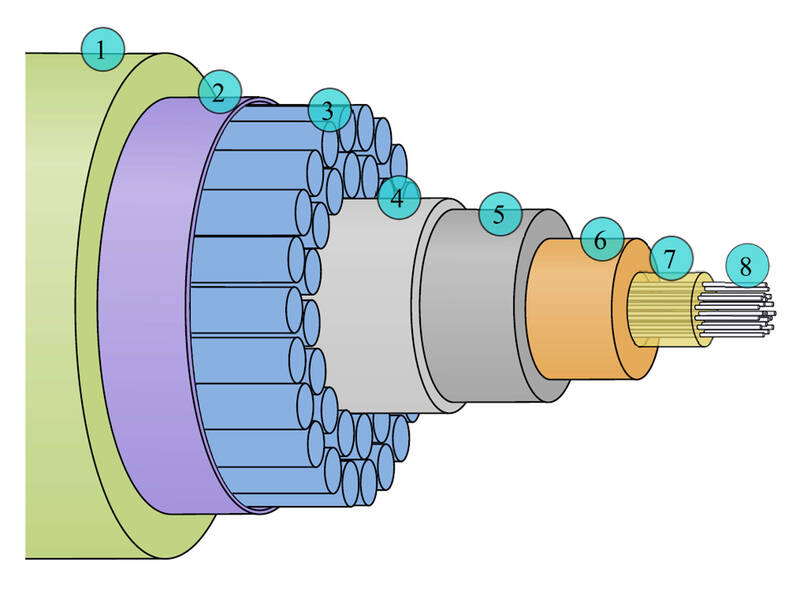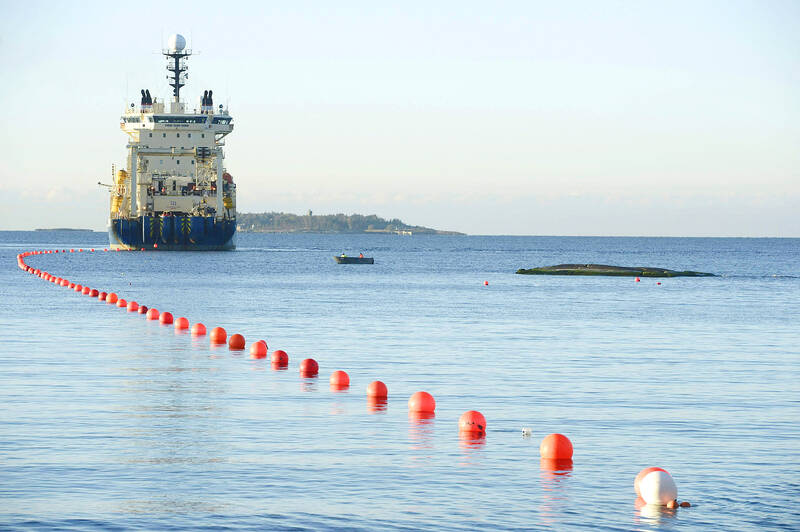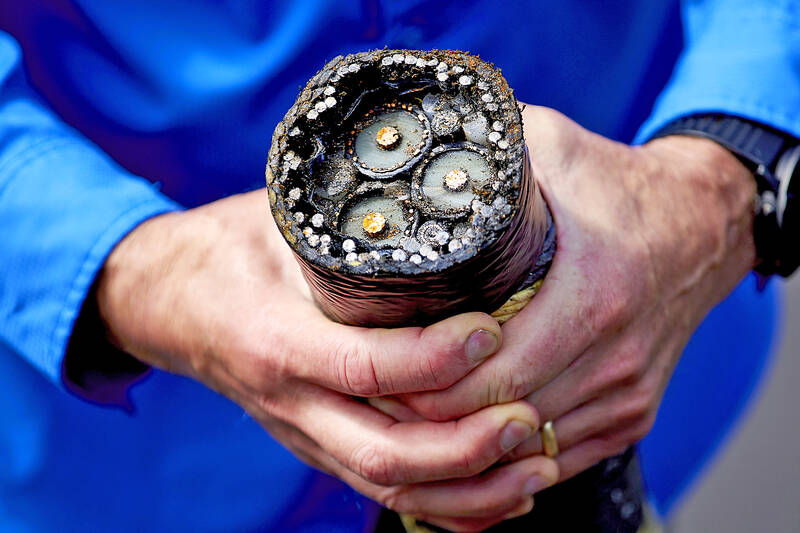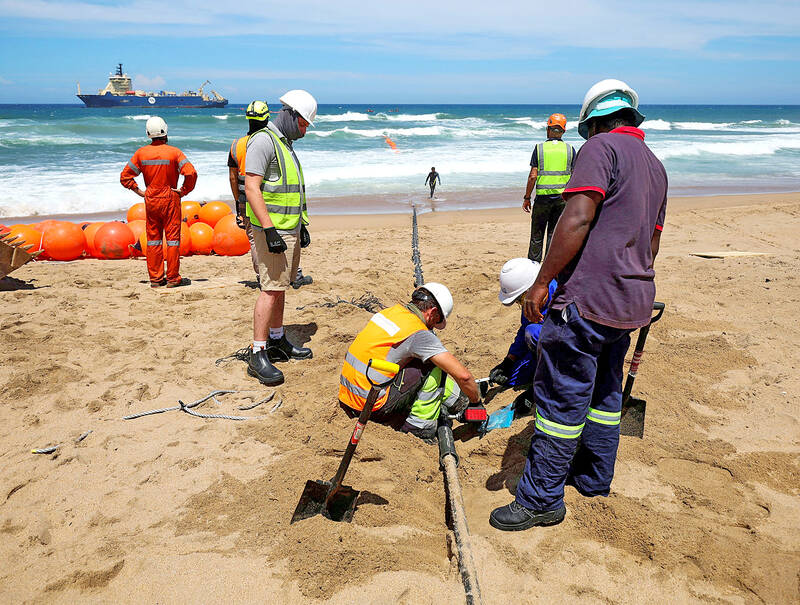Undersea cables are conductors wrapped in insulating materials and laid on the seabed. Their main functions are telecommunications or power transmission. The core of the undersea cables used for Internet signals is optical fiber, using light to transmit Internet signals.
Taiwan’s communications are currently handled by 10 domestic undersea cables and 14 international undersea cables. About 99 percent of Taiwan’s Internet bandwidth relies on undersea cables, making them Taiwan’s “digital lifeline.”
The demands on the cables’ bandwidth are only set to increase with the development of artificial intelligence (AI), which relies on the data fed into it. Today, data is an extremely important commodity.

Photo: Wikimedia Commons 照片:維基共享資源
With the development of the digital economy and the impact of the global pandemic, individuals, businesses and governments are highly dependent on Internet transmission, and so the cables are regarded as critical infrastructure for national security. Unfortunately, their high strategic value also makes them potential targets for attack.
As geopolitical tensions intensify in recent years, sabotaging undersea cables has become a tactical weapon in the “gray zone” between the rule of law and geography, due to the difficulties in law enforcement and accountability. However, they are also vulnerable to attack. Developing AI under such circumstances is like building luxury cars without properly maintaining the road infrastructure.
Finland and Estonia co-hosted a summit with NATO members from around the Baltic Sea in Helsinki on Tuesday last week to discuss measures to secure critical assets on the seabed. At the meeting, NATO Secretary-General Mark Rutte announced the launch of a mission dubbed Baltic Sentry, which will include frigates, maritime patrol aircraft and a fleet of naval drones to provide “enhanced surveillance and deterrence.”

Photo: AFP 照片:法新社
German Lieutenant-General Hans-Werner Wiermann, who previously led an undersea infrastructure coordination cell at NATO Headquarters, said no pipeline or cable can be guarded all the time. “The right response to such hybrid attacks is resilience,” he said. Laying more cables to add spare routings will allow critical pieces of infrastructure to keep working should a cable be cut.
To back up connections in the event of a failure, the Taiwan Space Agency in 2023 said it intends to launch its first self-made low-Earth orbit communication satellite next year and at least one more by 2028.
However, satellite communications are unlikely to replace submarine cables due to the large bandwidth gap. The bandwidth of a modern submarine cable can reach hundreds of Tbps per second (the MAREA submarine cable, for example, can reach up to 160 Tbps). Although satellites such as SpaceX’s Starlink can provide high-speed Internet, the bandwidth of a single satellite is usually only tens of Gbps. After being distributed among all users, the unit bandwidth is limited. After the completion of the Starlink full constellation project, Starlink is expected to provide approximately 20 Tbps of global bandwidth, only about 13 percent of a mainstream submarine cable.

Photo: AP 照片:美聯社
Li Jung-shian (李忠憲), professor of electrical engineering at National Cheng Kung University, pointed out that a resilient network is currently an important issue in Taiwan’s national security, especially since all military weapons are now controlled by information systems. Without information tools such as the Internet and satellite positioning, operations are bound to fail.
Satellite communications can make up for some of the connection needs in emergency situations, but it is difficult to replace the backbone position of undersea cables. Li believes that the Ministry of National Defense should establish a wartime routing and communication architecture, including backup undersea cables and satellite communications, wartime design of proxies and apps, VPN and proxy routing technology, and should conduct network resilience exercises.
(Lin Lee-kai, Taipei Times)

Photo: Reuters 照片:路透
海底電纜是用特殊絕緣材料包裹的導線,鋪設在海底,主要的功能是電信或電力傳送。用來傳送網路訊號的海底電纜,其核心是光纖,以「光」來傳輸訊號。
台灣目前由10條國內海纜與14條國際海纜擔起通訊重任。台灣約99%的網路頻寬都靠海纜,海纜的重要性如同台灣的「數位生命線」。
隨著人工智慧(AI)的發展——AI只能透過人們塞入其中的數據來滋養——對電纜頻寬的需求只會增加。如今數據是一種極其重要的商品。
由於數位經濟發展及全球疫情的影響,現今是個人、企業及政府皆對網路傳輸高度依賴的時代。因此,各國都將海底電纜視為國家安全的重要關鍵基礎設施,其高度的戰略價值也使它成為潛在的攻擊目標。
近年來隨著地緣政治緊張情勢加劇,破壞海底電纜成為遊走於法治與地域間的「灰色地帶」戰術利器,因其執法與究責之困難。海底電纜如此重要,卻又如此脆弱。在此狀況下誇言發展AI,如同道路基礎建設未妥善養護,而奢談造豪車。
有鑑於此,芬蘭及愛沙尼亞上週二在赫爾辛基共同主辦了峰會,與波羅的海週邊北約成員國討論保護海底關鍵資產的措施。北約秘書長馬克.呂特在會中宣布啟動代號「波羅的海哨兵」的行動,包括護衛艦、海上巡邏機與海軍無人機編隊,以「增強監視和威懾」。
曾在北約總部領導一個海底基礎設施協調小組的德國中將漢斯·沃納·維爾曼表示,任何管線或電纜都無法一直被保護著。他說:「對這種混合攻擊的正確應對,是恢復的能力」。因此必須鋪設電纜以增加備用路由,即便一條電纜被切斷,關鍵基礎設施仍能繼續運作。
台灣國家太空中心在2023年表示,為了在連線發生故障時有所備援,計畫在明年發射第一顆自製的近地軌道通訊衛星,並在 2028年前再發射至少一顆。
然而,衛星通訊難以取代海纜,因兩者頻寬差距很大,一條現代海纜的頻寬可達到每秒數百Tbps(如MAREA海纜,最高可達160 Tbps)。衛星(如SpaceX的Starlink)雖能提供高速網路,但單顆衛星的頻寬通常僅數十Gbps,分攤至所有使用者後,單位頻寬實際很有限。Starlink全星座計畫完成後預計可提供約20 Tbps的全球頻寬,僅相當於1條主流海纜的13%左右。
成功大學電機系教授李忠憲表示,韌性網路是目前台灣國家安全的重要議題,尤其現在所有的軍事武器都是由資訊系統來操控,若無網路、衛星定位等資訊工具,作戰一定失敗。
衛星通訊在應急情況下可彌補部分連線需求,但難以取代海纜的主幹地位。李忠憲建議,國防部應建立戰時路由與通信架構,包括備援海纜與衛星通訊、Proxy和App的戰時設計、VPN和代理路由技術,並應進行網路韌性演習。
(台北時報林俐凱)

In an effort to fight phone scams, British mobile phone company O2 has introduced Daisy, an AI designed to engage phone con artists in time-wasting conversations. Daisy is portrayed as a kindly British granny, exploiting scammers’ tendency to target the elderly. Her voice, based on a real grandmother’s for authenticity, adds to her credibility in the role. “O2” has distributed several dedicated phone numbers online to direct scammers to Daisy instead of actual customers. When Daisy receives a call, she translates the scammers’ spoken words into text and then responds to them accordingly through a text-to-speech system. Remarkably, Daisy

Bilingual Story is a fictionalized account. 雙語故事部分內容純屬虛構。 Emma had reviewed 41 resumes that morning. While the ATS screened out 288 unqualified, she screened for AI slop. She could spot it a mile away. She muttered AI buzzwords like curses under her breath. “Team player.” “Results-driven.” “Stakeholder alignment.” “Leveraging core competencies.” Each resume reeked of AI modeling: a cemetery of cliches, tombstones of personality. AI wasn’t just changing hiring. It was draining the humanity from it. Then she found it: a plain PDF cover letter. No template. No design flourishes. The first line read: “I once tried to automate my

Every May 1, Hawaii comes alive with Lei Day, a festival celebrating the rich culture and spirit of the islands. Initiated in 1927 by the poet Don Blanding, Lei Day began as a tribute to the Hawaiian custom of making and wearing leis. The idea was quickly adopted and officially recognized as a holiday in 1929, and leis have since become a symbol of local pride and cultural preservation. In Hawaiian culture, leis are more than decorative garlands made from flowers, shells or feathers. For Hawaiians, giving a lei is as natural as saying “aloha.” It shows love and

1. 他走出門,左右看一下,就過了馬路。 ˇ He walked outside, looked left and right, and crossed the road. χ He walked outside and looked left and right, crossed the road. 註︰並列連接詞 and 在這句中連接三個述語。一般的結構是 x, y, and z。x and y and z 是加強語氣的結構,x and y, z 則不可以。 2. 他們知道自己的弱點以及如何趕上其他競爭者。 ˇ They saw where their weak points lay and how they could catch up with the other competitors. χ They saw where their weak points lay and how to catch up with the other competitors. 註:and 一般連接同等成分,結構相等的單詞、片語或子句。誤句中 and 的前面是子句,後面是不定詞片語,不能用 and 連接,必須把不定詞片語改為子句,and 前後的結構才相等。 3. 她坐上計程車,直接到機場。 ˇ She took a cab, which took her straight to the airport. ˇ She took a cab and it took her straight